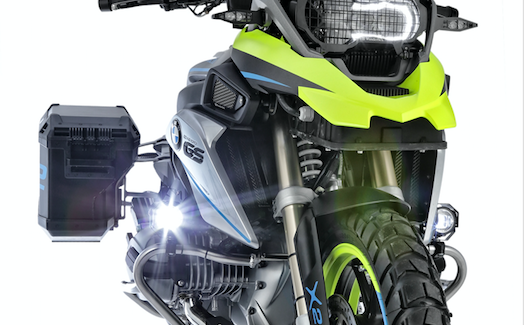BMW has long bucked the German stereotype of being humourless by engaging wholeheartedly in April Fools’ Day, usually by issuing a batch of press releases about ridiculous – but almost believable – new products.
This year was no exception, with a convincing-looking announcement for a two-wheel drive version of the R1200GS, using an electric motor to drive the front wheel while the usual boxer twin powered the rear. Dubbed the R1200GS xDrive Hybrid, it was just credible enough to fool a fair number of online blogs, closely mirroring the technology revealed in the Wunderlich X2 prototype that appeared in 2015.
But the prank turns out to be nearly identical to a real project the firm is working on. Just days before the 1 April press release, we uncovered a patent – written in 2015 and published in March 2017 – describing the same hybrid, 2WD bike. Whether the April Fool is an elaborate double-bluff or merely a coincidence, there’s no doubting its similarity.
The patent’s title, Motorcycle with an Electrically Driveable Front Wheel, clearly explains it and goes on to describe a hybrid bike that combines a conventional drive system to the rear wheel, powered by a petrol engine, with a hub-mounted electric motor that powers the front.
The idea isn’t completely new. KTM filed patents for a similar electric front-drive system several years ago, but closer still to the patent’s concept is the R1200GS-based Wunderlich X2.
That might not be a coincidence. The patent’s filing date is September 2015, just weeks before the Wunderlich X2 made its show debut. Furthermore, Wunderlich’s connections with BMW are extremely close, to the extent that BMW has occasionally used Wunderlich badges to disguise prototype bikes, making it look like they’re merely aftermarket-tuned machines. So it’s quite conceivable that the X2 could have been developed with some help from BMW itself, allowing the firm to try out its 2WD R1200GS in public without it appearing to be an official project.

Howsitwork?
In normal situations the bike is completely conventional, with all its power going to the rear wheel, but the front electric motor is always at the ready, able to cut in when required.
That need might arise when the rear loses traction, for instance. Many modern BMW motorcycles already have advanced traction control systems monitoring the rear grip and controlling wheelspin, but the addition of a front motor means that as well as cutting power to the rear wheel, traction control could also add some to the front to help drag the bike out of trouble.

whysitwork?
It could also be used purely to increase acceleration when there’s plenty of grip. And at low speeds it could help too – the patent explains that the motor’s ability to run backwards as well as forwards means it would give any bike fitted with the system a form
of reverse gear.
The battery in a hybrid like this could be compact and light. The hub motor doubles as a generator, allowing it to recharge the battery when you’re braking, so there’s no need to provide power to the front wheel for an extended period of time.

By Ben Purvis











